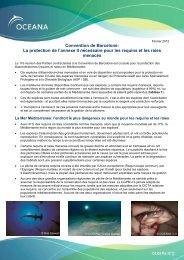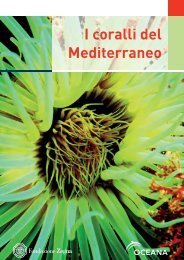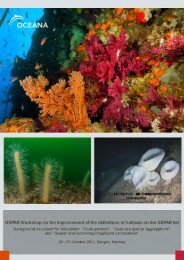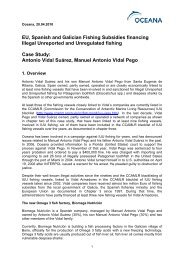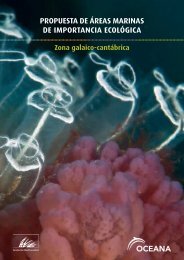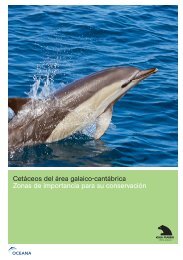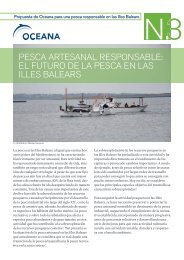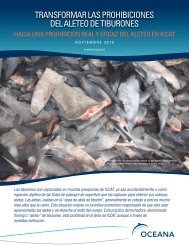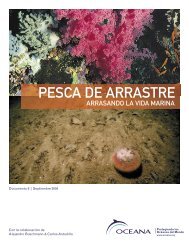Download "Seamounts of the Balearic Islands | 2010" - Oceana
Download "Seamounts of the Balearic Islands | 2010" - Oceana
Download "Seamounts of the Balearic Islands | 2010" - Oceana
You also want an ePaper? Increase the reach of your titles
YUMPU automatically turns print PDFs into web optimized ePapers that Google loves.
SEAMOUNTS OF THE BALEARIC ISLANDS | 2010<br />
36<br />
The most intense trawling in <strong>the</strong> area occurs in <strong>the</strong> red shrimp fishing grounds<br />
known as “la Mola” located approximately between 440 and 600 meters deep 52 on<br />
<strong>the</strong> elevation’s eastern slope. Therefore, studies at greater depths could reveal <strong>the</strong><br />
strong impact on this seamount’s benthic ecosystems. Trawling activities seem to<br />
take place in shallower areas in winter and spring.<br />
Although <strong>the</strong>re is a red shrimp trawling fleet in <strong>the</strong> Pitiusas, <strong>the</strong> fleet that operates<br />
on Ausias March most likely comes from peninsular ports like La Vila Joiosa,<br />
Santa Pola or Xávea, authorised to operate in <strong>the</strong>se red shrimp fishing grounds at<br />
isobaths over 400 m 53 . Never<strong>the</strong>less, trawling marks that may have been caused by<br />
<strong>the</strong> local trawling fleet, have also been identified in shallower areas.<br />
In <strong>the</strong> case <strong>of</strong> Ses Olives, fishing activities consist <strong>of</strong> traps to catch Plesionika<br />
shrimp and surface longlines for large migratory species like swordfish (Xiphias<br />
gladius). Lost fishing gear, mainly lines, were also documented on <strong>the</strong>se seabeds.<br />
Emile Baudot was in fact subjected to bottom trawling during <strong>the</strong> 80’s to target<br />
shrimp (Aristeus antennatus), although this activity ceased when new management<br />
measures limiting fishing effort entered into force, such as <strong>the</strong> implementation<br />
<strong>of</strong> time restrictions for fishing, which made <strong>the</strong> fleet abandon this fishing<br />
ground because it was located too far away. 54<br />
Today, <strong>the</strong> most important fishing activity on Emile Baudot is recreational fishing<br />
targeting large species such as wreckfish and groupers (Polyprion americanus,<br />
Epinephelus spp.). <strong>Oceana</strong> observations have however, revealed that some <strong>of</strong> <strong>the</strong><br />
larger rocks are completed covered by fishing gear, including nets and lines.<br />
As mentioned above, fishing constitutes one <strong>of</strong> <strong>the</strong> main threats to <strong>the</strong> conservation<br />
<strong>of</strong> seamount ecosystems. Thus, specific management measures must be implemented<br />
for <strong>the</strong>se areas, not only to conserve biodiversity, but also to conserve<br />
<strong>the</strong> live resources <strong>the</strong>se seamounts harbour. Taking into account <strong>the</strong> importance <strong>of</strong><br />
<strong>the</strong> ecosystems in <strong>the</strong>se areas and <strong>the</strong> role <strong>the</strong>y play in <strong>the</strong> different stages <strong>of</strong> <strong>the</strong><br />
life cycles <strong>of</strong> overexploited commercial species, <strong>the</strong>se measures must necessarily<br />
include partial or total restriction <strong>of</strong> fishing activities, depending on <strong>the</strong> type <strong>of</strong><br />
fishing gear used and <strong>the</strong> different impacts <strong>the</strong> activity has on <strong>the</strong> exploited area.<br />
As indicated by <strong>the</strong> Food and Agriculture Organization <strong>of</strong> <strong>the</strong> United Nations<br />
(FAO) 55 , fishing is not <strong>the</strong> only threat to vulnerable marine ecosystems; waste<br />
dumping, contamination, mineral drilling/exploitation and climate change must<br />
also be taken into account.<br />
The most obvious anthropogenic effects identified on <strong>the</strong>se seamounts are remnants<br />
<strong>of</strong> waste and fishing gear (buoys, lines, nets, hooks, etc.)- plastics, food<br />
packaging, bottles, fabrics, jars, canisters, metal waste, etc.<br />
Although <strong>the</strong>re is no data available on how <strong>the</strong> communities present on <strong>the</strong>se<br />
seamounts are affected by this waste, one <strong>of</strong> <strong>the</strong> most serious threats may be<br />
acidification. Ses Olives is an area where an important presence <strong>of</strong> pteropods has<br />
been observed, a taxa that is extremely vulnerable to changes in sea water pH.<br />
Important coral and gorgonian communities have also been observed on both<br />
Emile Baudot and Ausias March, species that are very sensitive to modifications<br />
in sea water chemistry and temperature.<br />
In fact, important extensions <strong>of</strong> dead corals were identified on Emile Baudot between<br />
250 and 350 meters deep, although <strong>the</strong>ir cause <strong>of</strong> death is unknown.



